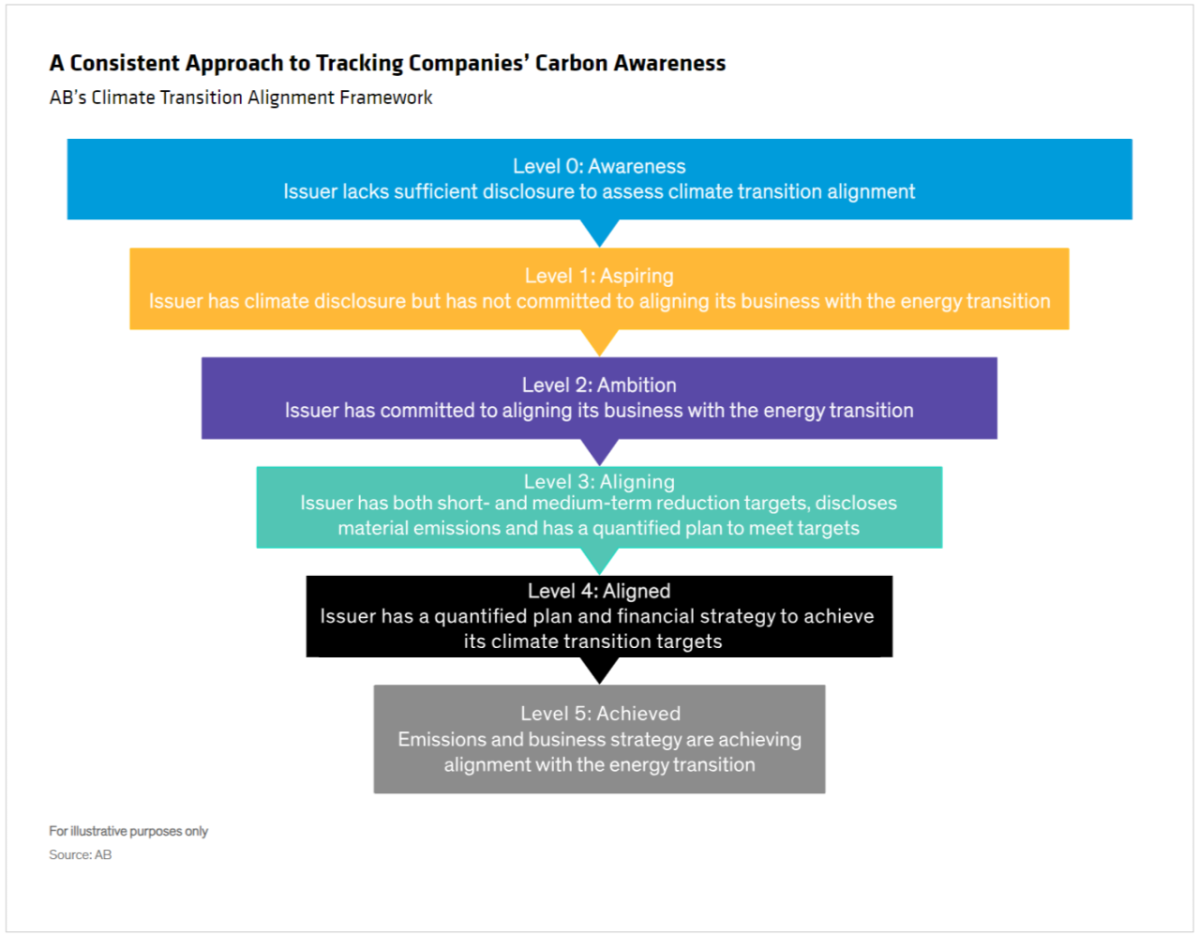AB: Getting Ahead of Climate Transition Risks and Opportunities
Published 09-05-24
Submitted by AllianceBernstein

ESG in Action
Governments, regulators and consumers are pressing for change from carbon-based to renewable energy sources. That shift will involve huge upheaval for the world economy and the businesses that drive it. Investors and companies need a framework to analyze and manage the risks and opportunities of the transition.
The Issue
High greenhouse gas (GHG) emitting companies are under pressure to adapt their business operations to a clean-energy future.
The Investment Case
The transition involves multiple risks for corporates. But it also creates opportunities for them to innovate and to leapfrog competitors by preparing successfully for a low-carbon world.
Engagement Is Key*
Based on our climate transition alignment framework, we assess high GHG emitting companies’ transition readiness and engage with their management to help them navigate the new environment. We believe this process is vital to identify transition winners and losers and to support stock and bondholder returns.
Authors
Erin Bigley, CFA| Chief Responsibility Officer
Sara Rosner| Director of Environmental Research and Engagement
Bob Herr| Director of Corporate Governance
Companies emitting high levels of GHG face complex challenges as they prepare for a low-carbon world. Our experience shows how constructive engagement can help support business strategies and investors’ returns.
Companies Face Pressure from Transition Risks
According to the International Energy Agency, demand for oil and gas is set to peak by 2030 as energy generation becomes less dependent on hydrocarbons—a scenario creating multiple business risks for heavy industries. High-carbon emitting companies are under pressure from governments and stakeholders to decarbonize their businesses. They must adapt to a raft of new policies, regulations and reporting requirements. Difficulties in securing financing and insurance will likely make it pricier to obtain capital. Products face obsolescence, and assets may be stranded—made less valuable or outdated.
However, these challenges also provide a spur to adopt new technologies and to improve competitive positioning versus peers.
Assessing Exposure: Creating a Consistent Approach
Given the wide-ranging effects of the transition—both positive and negative—on many aspects of firms’ business models and operations, analyzing and managing investment exposure is an expansive task.
AllianceBernstein’s climate transition alignment framework (CTAF) is one approach to tackling the challenge of pinpointing transition risks and opportunities. It’s inspired by several similar frameworks promoted by experts and industry organizations. But AB’s CTAF isn’t intended to be a mandatory route to net zero emissions, nor a way to assess transition risk through a single backward-looking metric, such as a carbon footprint. Instead, it helps us better understand companies’ unique paths for navigating a lower-carbon future.
The CTAF starts by identifying companies in certain high-impact industries (such as airlines, autos, energy and utilities) that are the biggest drivers of financed emissions in actively managed equity and fixed-income portfolios. Investment teams assess these companies on a five-point scale, tracking their journeys from having no awareness of climate risk (Level 0) to full alignment with a lower-carbon world (Level 5).

Engaging for Action: Clarity and Shared Insight
After our CTAF analysis has helped identify the key facts and where a company stands on its trajectory, we’re better equipped for the next step: engaging with company management.
Recent engagements include firms across the aerospace and defense, oil and gas, and energy utilities sectors. Dialogues have typically been productive for both sides: using our CTAF approach, we’ve been clear about progress we’d like to see in companies’ management of material climate-related transition risks and opportunities. Management teams have been informative, keen to understand our expectations and receptive to our feedback.
For example, we recently engaged the management team of a US energy company involved in hydrocarbon exploration to gain greater clarity on their plans to reach their stated target of achieving net zero by 2040. The company shared details on their interim target-setting for Scopes 1 and 2 emissions, their exploration of various emissions reduction strategies, and their readiness for expected climate regulatory reporting requirements; we suggested potential starting points for Scope 3 emissions target setting.
That collaborative style of engagement is a far cry from the adversarial approach some might imagine. But in reality, it’s important that these occasions enable an exchange of views. Two-way engagement gives investment teams a clearer understanding of the nuances of each company’s situation—and helps them put the facts into context. This can go a long way toward highlighting risks and opportunities that can be material to a company’s business and performance.
Disclosures are a good example. Investors value meaningful climate-related disclosures both as the basis for making more informed decisions about risks and returns and as proof that corporate management can measure and manage the associated hazards and opportunities. Although companies may be willing to provide the requisite data, these might be problematic to compile, either because of regulatory uncertainties or difficulties in establishing a consistent, robust methodology.
Companies aren’t cut from the same mold, so it’s also important to consider each firm’s specific circumstances, account for its particular industry background and understand its competitive positioning relative to peers. As investors, we want to ensure that companies have a sustainable future—and managing climate risks is part of achieving that future.
We prefer that management makes climate-related changes thoughtfully and achievably in the interests of the business, so our engagements aren’t about idealistic target-setting but about managing material risks and opportunities that can stem from decarbonization.
Voting with Purpose: Will a Proposal Enhance Shareholder Value?
Voting at shareholder meetings puts considerable influence in the hands of investors, so it’s important that we cast our votes responsibly and constructively. Our touchstone is whether a proposal can enhance shareholder value through better management of business risks and opportunities.
To help gauge its likely impact, we evaluate each proposal’s materiality, transparency and prescriptiveness. For issuers that fall under the CTAF, we apply insights and knowledge from our own assessments and engagements to balance the importance of the issues with the regulatory and disclosure constraints companies face.
It’s a considered approach that results in a variety of voting outcomes, as these example voting decisions from 2024 highlight.
Vote in Favor—Encouraging Better Disclosure and Accountability: A US utilities firm received a shareholder proposal to report on the feasibility of integrating targets to reduce greenhouse gas (GHG) emissions into executive compensation. We believed that supporting the proposal would encourage greater disclosure and accountability from management, which in our view had provided substandard environmental reporting disclosure on these material topics.
Vote Against—Unnecessary Emissions-Reduction Targets: Conversely, at another US utility meeting, we voted against a shareholder proposal asking the company to adopt GHG emissions-reduction targets across its full value chain in alignment with the Paris Agreement. Considering the company’s existing comprehensive emissions commitments, backed by state regulators, we believed additional targets were unnecessary.
Abstain—Providing More Time for Progress. A European integrated oil and gas company proposed a commitment to achieving net zero Scopes 1 and 2 GHG emissions by 2050—but omitted about half its overall Scope 3 emissions in its “Scopes 1, 2 and 3” target. We expressed our concerns to company management; however, when it came to the vote, we concluded that shareholders’ interests were best served by giving the company extra time to address the issue.
The 2024 proxy season saw a prominent focus on shareholder proposals related to Scope 3 emissions disclosure and reductions. We generally abstained on Scope 3-related company meeting proposals for the companies we evaluated using CTAF, reflecting the same attempt to balance the importance of comprehensive emissions disclosures with an acknowledgement of regulatory uncertainty and the challenges of measuring and managing such emissions, which take time and resources to address.
Moving Forward
Implementing the CTAF is a multiyear, ongoing assessment process for us. Over time, we’ll apply it to continue monitoring and benchmarking companies’ progress in mitigating material climate transition risk—and to inform our voting intentions.
Of course, we’ll continue to consider the nuances of each individual situation and proposal. But ultimately, we need the companies we invest in to be well prepared for the risks and opportunities of a low-carbon economy.
Additional Contributors: Cole Moore - Investment Stewardship Associate
*AB engages issuers where it believes the engagement is in the best interest of its clients.
The views expressed herein do not constitute research, investment advice or trade recommendations and do not necessarily represent the views of all AB portfolio-management teams. Views are subject to change over time.
Learn more about AB’s approach to responsibility here.

AllianceBernstein
AllianceBernstein
AllianceBernstein (AB) is a leading global investment management firm that offers diversified investment services to institutional investors, individuals, and private wealth clients in major world markets.
To be effective stewards of our clients’ assets, we strive to invest responsibly—assessing, engaging on and integrating material issues, including environmental, social and governance (ESG) considerations into most of our actively managed strategies (approximately 79% of AB’s actively managed assets under management as of December 31, 2024).
Our purpose—to pursue insight that unlocks opportunity—describes the ethos of our firm. Because we are an active investment manager, differentiated insights drive our ability to design innovative investment solutions and help our clients achieve their investment goals. We became a signatory to the Principles for Responsible Investment (PRI) in 2011. This began our journey to formalize our approach to identifying responsible ways to unlock opportunities for our clients through integrating material ESG factors throughout most of our actively managed equity and fixed-income client accounts, funds and strategies. Material ESG factors are important elements in forming insights and in presenting potential risks and opportunities that can affect the performance of the companies and issuers that we invest in and the portfolios that we build. AB also engages issuers when it believes the engagement is in the best financial interest of its clients.
Our values illustrate the behaviors and actions that create our strong culture and enable us to meet our clients' needs. Each value inspires us to be better:
- Invest in One Another: At AB, there’s no “one size fits all” and no mold to break. We celebrate idiosyncrasy and make sure everyone’s voice is heard. We seek and include talented people with diverse skills, abilities and backgrounds, who expand our thinking. A mosaic of perspectives makes us stronger, helping us to nurture enduring relationships and build actionable solutions.
- Strive for Distinctive Knowledge: Intellectual curiosity is in our DNA. We embrace challenging problems and ask tough questions. We don’t settle for easy answers when we seek to understand the world around us—and that’s what makes us better investors and partners to our colleagues and clients. We are independent thinkers who go where the research and data take us. And knowing more isn’t the end of the journey, it’s the start of a deeper conversation.
- Speak with Courage and Conviction: Collegial debate yields conviction, so we challenge one another to think differently. Working together enables us to see all sides of an issue. We stand firmly behind our ideas, and we recognize that the world is dynamic. To keep pace with an ever changing world and industry, we constantly reassess our views and share them with intellectual honesty. Above all, we strive to seek and speak truth to our colleagues, clients and others as a trusted voice of reason.
- Act with Integrity—Always: Although our firm is comprised of multiple businesses, disciplines and individuals, we’re united by our commitment to be strong stewards for our people and our clients. Our fiduciary duty and an ethical mind-set are fundamental to the decisions we make.
As of December 31, 2024, AB had $792B in assets under management, $555B of which were ESG-integrated. Additional information about AB may be found on our website, www.alliancebernstein.com.
Learn more about AB’s approach to responsibility here.
More from AllianceBernstein

